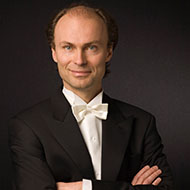At A Glance
BERG
Seven Early Songs 1908/1928 | 15 mins
No young composer sits down and writes a work to which he gives the title of Seven Early Songs, and this rings true for Alban Berg. He was actually in his forties when he culled these seven songs for publication from the eighty-six he had composed between 1900 and 1908. These performances feature a revised and orchestrated version by the composer. LISTEN FOR: Berg had a lifelong preoccupation with symmetry, and we hear this take shape in the Seven Early Songs. As Berg's biographer Douglas Jarman notes, they are ordered in "a symmetrical shape upon the group by scoring the third song for strings and the fifth for wind alone, the second and sixth for reduced orchestra, and the first and seventh songs for full orchestra, so that the whole set pivots around the central fourth song." MORE
BEETHOVEN
Symphony No. 9 in D minor, Opus 125 1824 | 66 mins
The Ninth is Beethoven’s last symphony, a beacon of the avant-garde. It takes on a magnified aura of monumentality—of finality, on one hand, but also as an utterly uncharted challenge to future generations of composers.
Beethoven sets us on a musical journey from darkness into light. Mystery shrouds the opening. We enjoy a wealth of melodies ahead of an apocalyptic ending. Hammer-blows launch us into the Molto vivace second movement, and return throughout to interrupt the elfin scurry of the music. At times the pounding leads to a galumphing swagger, all the more resonant after the gentle, woodwind-laden melodies of the movement’s middle section. The Adagio introduces the soulful side of Beethoven, greatly in contrast to the athleticism of what we have just heard. Its hushed spell is broken by a horrific explosion by the orchestra that is punctuated by the most curious thing—a tune played by the cellos and basses, alone. This is the beginning of the grand Finale. The music seems to be asking questions, and the orchestra responds with answers that allude to music we have heard before. After considerable back-and-forth the low strings announce the famous theme that fuels a movement of variations. The first three of these variations involve instruments only until finally the bass vocalist sings: “Oh friends, no more of these sounds! Instead, let’s strike up a song that’s more pleasant, And more joyful.” LISTEN FOR: Then—one of the most famous passages in all of music, intoned to Friedrich von Schiller’s ode “To Joy.” By way of more variations—as sundry as a “Turkish march,” a vigorous section full of overlapping themes, and some passages of high-wire vocalizing—Beethoven leads us through his grand choral finale.
In short: This music is about the hopes and dreams of humankind. MORE
Jeanette Yu is Editorial Director at the San Francisco Symphony.

